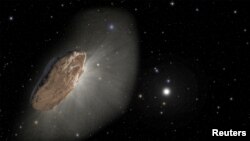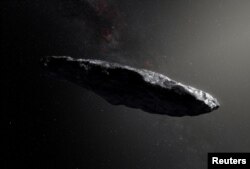‘Oumuamua is the first object found visiting our solar system from another solar system. It is a comet that was first discovered in 2017. Scientists observed the comet accelerate in an unusual way as it moved away from the sun.
Scientists have offered different theories for this unexpected behavior. Among the theories is the idea that the object is an alien spaceship. But a new study has offered a clearer explanation – that ‘Oumuamua’s increase in speed was caused by the release of hydrogen gas as the comet warmed up in the sunlight.
‘Oumuamua lacks the tail of gas and particles common in many comets. It has been described as being shaped like a tube but now is thought to be thin, round, and flat. It is smaller than first estimated. It is now thought to be around 115 meters by 111 meters, with a thickness of about 19 meters.
Researchers said it appears that ‘Oumuamua was born like many other comets as what is called a planetesimal. A planetesimal is a small object formed in the early period of planet formation. Researchers described ‘Oumuamua as a large, icy space rock.
The comet then somehow left the solar system where it formed. Scientists said the comet’s chemistry changed as it received high-energy radiation traveling through interstellar space. The radiation changed some of the comet’s ice into hydrogen gas that became trapped.
‘Oumuamua then warmed up as it passed through our inner solar system. The heating caused the comet’s ice structure to release the trapped hydrogen gas. That accelerated ‘Oumuamua as it headed away from the sun. The release of this hydrogen in a process called outgassing would not cause an observable tail.
Jenny Bergner is a University of California, Berkeley astrochemist. She is the lead writer of the research published recently in Nature.
She said the important finding is that ‘Oumuamua might have started as an icy planetesimal with a lot of water, similar to comets in our own solar system. She added that this model can explain the strange behavior of ‘Oumuamua without needing to use unusual physics or chemistry.
Darryl Seligman of Cornell University also helped write the study. He said, “The simplest explanation, and exactly what we would expect for an interstellar comet, fits all of the data with no fine-tuning.”
The name ‘Oumuamua comes from the Hawaiian language and means a messenger arriving from a great distance. It was first discovered by the University of Hawaii’s Pan-STARRS1 telescope.
Bergner said, “We don't know its place of origin but it was probably traveling through interstellar space for less than 100 million years. It had a reddish color consistent with the colors of many small bodies in the solar system. It is currently past Neptune on its way out of the solar system.”
A second interstellar object was discovered visiting our solar system in 2019. It is a comet called 2I/Borisov. Its behavior has been more like a usual comet.
These alien visitors may be more common than had been thought. The researchers said one to two interstellar objects might be discovered every year in our solar system once a new astronomy center in Chile begins operations as planned next year.
I’m Gregory Stachel.
Will Dunham reported this story for Reuters. Gregory Stachel adapted it for VOA Learning English.
____________________________________________________________________
Words in This Story
comet – n. an object in outer space that develops a long, bright tail when it passes near the sun
accelerate – v. to gain speed
alien – adj. from somewhere other than the planet Earth
tail – n. a long piece that extends from the back end or bottom of something
interstellar – adj. existing or occurring between stars
astrochemistry – n. the study of the chemical substances and species occurring in stars and interstellar space
fine-tune – v. to make small changes to (something) in order to improve the way it works or to make it exactly right
origin –n. the place or period of something’s beginning; where something came from
consistent – adj. in agreement with something
___________________________________________________________________
What do you think of this story?
We want to hear from you. We have a new comment system. Here is how it works:
- Write your comment in the box.
- Under the box, you can see four images for social media accounts. They are for Disqus, Facebook, Twitter and Google.
- Click on one image and a box appears. Enter the login for your social media account. Or you may create one on the Disqus system. It is the blue circle with “D” on it. It is free.
Each time you return to comment on the Learning English site, you can use your account and see your comments and replies to them. Our comment policy is here.










Forum